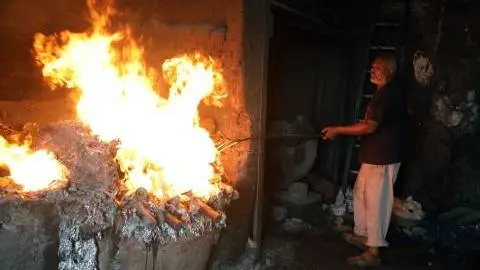Greening aluminium: Ambitious goals on decarbonisation, but little progress
All major aluminium producers have set ambitious net zero decarbonisation targets from 2050 onwards. However, apart from a modest reduction in greenhouse gas (GHG) emissions in the past five years, we haven’t seen much progress to date
Decarbonisation has been slow and unimpressive
We have taken a closer look at the top 8 global aluminium producers* (accounting for 40% of global aluminium production) for the period between 2018 and 2023. We looked through their annual sustainability and climate progress reports to gauge production performance, climate targets and strategy and progress on decarbonisation over the last six years.
So, below, we're giving you a brief review of those selected companies' climate goals and statistics obtained from their annual reports. And we can confidently state that decarbonisation so far has been slow and unimpressive. In fact, some companies state they'll emit more tonnes of greenhouse gasses (GHG) up to 2030 and only then will they start the long-distance marathon towards ambitious net-zero targets.
Here are our key findings.:
Climate goals and carbon emission disclosure practices have improved since regulators worldwide implemented requirements for carbon emission disclosure reports as part of wider Sustainability initiatives.
Sustainability reporting requires improved disclosure of environmental expenditures. Environmental investment might be spread between operational and capital expenditure or cannot be disclosed properly under existing regulations. We cannot state with any certainty how much the sector is investing in decarbonisation now and how much this amount has changed over recent years. We believe that further development of sustainable reporting disclosures is an important topic, especially for corporates in non-EU jurisdictions.
Consolidated aluminium production of the top-8 producers reached 150.6mt in the six years between 2018 and 2023; Annual production from the top-8 reached 27.7mt in 2023 (+13.5% vs 2018), with total 2023 global aluminium production at 70.5mt.
Global aluminium supply & demand, sector GHG emissions

Aluminium production by the 8 largest producers
(mt)
Accumulated (Scope 1 and Scope 2) GHG emissions by the top-8 producers reached 1,772 million tonnes of CO2e between 2018 and 2023. 2023 Scope 1 and Scope 2 GHG emissions increased by 21% vs 2018, to 326mt of CO2e.
Scope 1 GHG Emissions by the 8 largest aluminium producers
(mt CO2e)
Scope 2 GHG Emissions by the 8 largest aluminium producers
(mt CO2e)
Signs of hope
In 2023, annual consolidated GHG emissions (Scope 1 and Scope 2) from the top-8 aluminium producers dropped to 326mt from 332mt in 2022. Annual aluminium production remained flat at about 39mt.
Scope 1 and Scope 2 GHG Emissions by the 8 largest aluminium producers
(mt CO2e)
The sector’s blended carbon emissions intensity** in 2023 dropped from 12.17 tonnes of CO2e per tonne of aluminium produced to 11.77 tonnes of CO2e per tonne of aluminium produced. Compared to 2018, carbon emission intensity grew by 6.6%.
Reported carbon emissions' intensity at the 8 largest aluminium producers

Calculated carbon emission intensity at the 8 largest aluminium producers
(tonne of CO2e/tonne of aluminium)
Key questions on decarbonisation
Has any company made progress towards decarbonisation?
Yes, almost all of them, but not enough to achieve a visible slowdown in emissions. The level of emissions from primary aluminium production depends on the type of raw material (bauxite, alumina or aluminium scrap), the technology for processing it into primary aluminium or aluminium products, the energy efficiency of such technology, and the structure of energy sources (including the percentage from renewable sources). As seen in company reports, the most visible progress on overall emission cuts has been through switching from coal to hydropower by corporates in China, although these producers remained the largest carbon emitters globally. Almost all major corporates have launched special low-carbon aluminium brands (with up to 4.0 tonnes of CO2e per tonne of aluminium), utilising a combination of energy-efficient technology and a high share of renewable energy sources. That said, sales volumes of low-carbon aluminium remain insignificant.
Do the companies invest in decarbonisation?
Yes, but published reports reveal concrete levels for only a few of them. Of the corporations we looked at, relevant data was published by Norway-based Norsk Hydro thanks to EU Taxonomy regulation; its environmental expenditures comprised around 29% of overall Capex (c.$719m). The companies studied tend not to disclose detailed environmental investment amounts and offer only limited data.
Do producers have sufficient resources to invest in decarbonisation?
Aluminium corporates appear to be at low leverage and profit making, while the groups controlling aluminium businesses usually pay dividends. In 2023, we calculate that average Net Debt/ EBITDA of the top-8 producers was 0.8x. Consolidated net income reached US$13.9bn, operating cash flow US$32bn, Capex US$7.0bn, free cash flow from operations before dividends US$12.bn and total dividend payments US$11bn.
Is it only aluminium producers responsible for carbon emissions in the aluminium sector?
Not at all. While changing energy sources and developing technologies might significantly reduce emissions as we move towards net-zero emissions, customers of aluminium producers also need to pay more. According to Norsk Hydro, the current potential demand for low-carbon aluminium is estimated at 16mt of more than 70mt of global aluminium demand. A major portion of aluminium sector customers still prefer to buy cheap, carbon-intensive aluminium. The source of energy is also important when aluminium companies cannot swiftly switch from one energy supplier to another - Hillside Aluminium of South32 purchases coal–generated energy from Eskom (a key customer in the region with a long-term energy supply contract).
Corporate strategy and effectiveness also depend on the smelter’s location, jurisdiction, national environmental strategy, the host country’s environmental commitments, and the strategies and power sources that aluminium companies use. For example, Vedanta is increasing its GHG input while India is adding thermal power generation. China is making efforts on transition but stipulates that its carbon emissions should peak only by 2030. South32 is restricted in emission reductions due to its contract with coal power energy supplier Eskom.
You may be able to view more detailed corporate analysis on our investment research website at https://research.ing.com.
Footnotes:
* We look at the eight largest aluminium producers which release publicly available sustainability and/or climate progress reports and carbon emission statistics. These are Rio Tinto, Aluminium Corporation of China Limited (CHALCO), China Hongqiao Group Limited (Hongqiao), Norsk Hydro (Hydro), ALCOA, Vedanta, South32 and UC RUSAL (US RUSAL remains under various sanctions)
** The sector’s blended carbon emission intensity for the eight companies we looked at is the ratio of consolidated emissions to aluminium production.
This publication has been prepared by ING solely for information purposes irrespective of a particular user's means, financial situation or investment objectives. The information does not constitute investment recommendation, and nor is it investment, legal or tax advice or an offer or solicitation to purchase or sell any financial instrument. Read more
Tags
Sustainability Metals & Mining ESG Emerging markets Decarbonisation Climate change Carbon emissions AluminiumDownload
Download article
14 November 2024
Greening aluminium: Its less than shiny net-zero reputation This bundle contains 3 Articles




